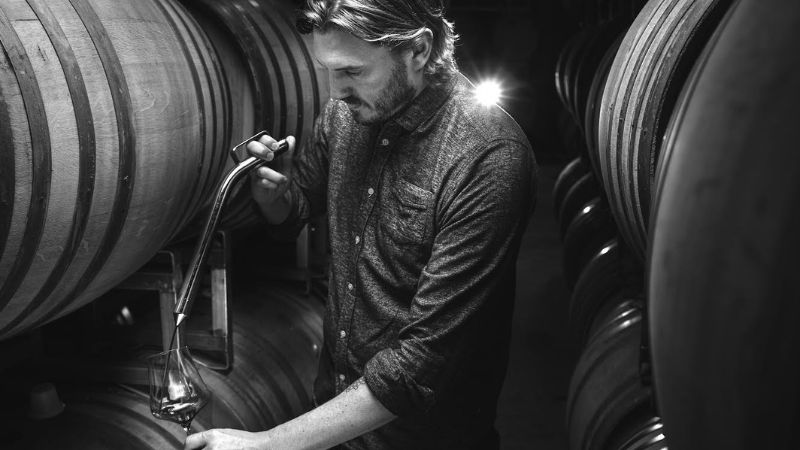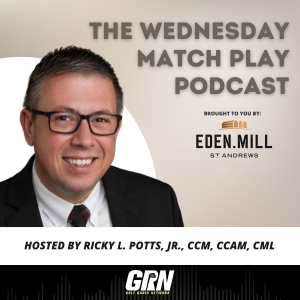While living in Santa Rosa, Sheryl and I fell in love with wine. We do enjoy visiting breweries and trying local craft beers, but some of the best wines in the world are being made in Sonoma County. There are more than 425 wineries in Sonoma County. Not far from home was Napa Valley, another fun place to drink wine. You can find another 450 wineries in Napa. Needless to say, we spent a lot of time tasting wines and getting to know all the winery owners and winemakers in the area. But we had to move to Palm Desert to discover Ernest Vineyards, a family owned winery founded by Erin Brooks and Todd Gottula.
I work at The Lakes Country Club, and we recently hosted a Wine Education with Mark Malpiede, President, Ernest Vineyards. We got the chance to spend time learning more about the winery, his journey to Ernest Vineyards, and enjoyed a delicious wine dinner paired with several of their unique wine, including their Pinot Noir, Chardonnay and Picpoul, a crisp, refreshing white wine made exclusively from the ancient Picpoul grape variety. It was a great session and I learned a lot about the brand. To learn more, I went on their website where I found a Live Chat. I started chatting with Caitlin O’Connell, Experience Engineer. We had a nice conversation and she lined up an interview with their winemaker. It was in the middle of harvest, but Joseph took the time to sit down, pour a glass of wine, and answer a few questions. This was a fun, and delicious, interview. It is my pleasure to introduce you to Joseph, winemaker, Ernest Vineyards. Cheers!
Ernest Vineyards – A family owned winery that produces site specific Chardonnay and Pinot Noir from the West Sonoma Coast
Since we know you’re wondering: Yes, there was a man named Ernest. He was an entrepreneur, a risk-taker and a role model for his grandson, Todd Gottula, who founded our winery with his wife, Erin Brooks, back in 2012. Today, the “Ernest” in our name stands for more than one man. It’s about integrity in the fruit we use and the people we know. It’s about restraint, about how ego drives nothing we do.
Can you give me an overview of Ernest Vineyards? Where are you located and how long have you been making wines there?
Erin and Todd started Ernest in 2012 so we just celebrated our 10 year anniversary. Their goal was to highlight the possibilities of crafting world class Pinot Noir and Chardonnay from the cool, foggy West Sonoma Coast. I joined the team in 2018, a year after they moved into Grand Cru Custom Crush, a facility in which they partnered with Robert Morris to develop.
The Lakes Country Club recently hosted the RoadRunner Region Wine Dinner featuring several Ernest Vineyards wines. That dinner is actually what led to this interview! Not really a question, just thanking you and the team at Ernest Vineyards for making this dinner possible. Cheers!
Thank you for pouring our wines. We truly cherish the opportunity to meet and connect with new folks.
Before dinner, attendees enjoyed Wine Education presented by Mark Malpiede, President. He spoke at length on Erin Brooks and all she’s done to make Ernest Vineyards possible. Can you tell me more about Erin and her time at Ernest Vineyards?
Erin came from a small town in Texas to software sales in San Francisco. Her first career lead her to wanting to navigate a wine list with knowledge and authority. When the wine bug gets you, there’s really no other choice but to dig in deeper! She has since grown Ernest quite impressively in our 10 years as well as Presiding over the West Sonoma Coast Vintners association and sitting on the board of Sonoma County Vintners. She is passionate, gracious and a whole lot of fun to make wine with!
Can you tell me more about Grand Cru? I need to come visit!
In the world of CA wine, unless one is born onto an estate property or has endless investment capital, the path to production is a custom crush facility. Grand Cru takes that idea a step further with top notch service in an immaculate facility as well as having tasting salons in the FOH where each winery can host by appointment. The shared resources help minimize overhead enabling young brands to learn and grow.
Do you ever make a mistake? If so, what are some common mistakes winemakers make and how do you recover not to lose any juice?
Never. Ha! I learned, very early on, that most interventions during the production of wine cannot be undone. We take the philosophy that if its grown well, the wine will find itself with little input. That said, I’ve knocked valves off of tanks full of grapes, broken equipment and racked one wine when I meant to rack another. I minimize these mistakes by staying present in the winery. Going slowly and methodically about each task until I’m satisfied.
Speaking of education, where did you study?
No formal education though I grew up in a farming family. I came to wine from restaurants in NYC. I went to every tasting and educational event that I could find, thinking I wanted to become a Sommelier. I spent a lot of time in France and then came to California to work harvest and never looked back. There is an amazing amount of continuing education resources in Sonoma County, from classes at the JC to the Wine Research Section of Healdsburg public library.
How did the Tubbs Fire impact your operation?
Tubbs Fire, Kincade Fire Walbridge Fire, Glass Fire, LNU Lightning Complex fires. They have all impacted us. In some cases, the grapes were all in, so we could focus on staying safe and evacuating if need be. In others, we lost whole crops to smoke taint as well as losing homes to fires themselves. We are endlessly grateful for vintages without smoke or fire.
Let’s go shopping! How do you know how much to charge? And does the price reflect the quality of the wine?
Around the world there are many different financial considerations when crafting a bottle of wine. In California, the North Coast in particular, the cost of land is very expensive. Start there. We either grow the grapes or buy them from growers. Ernest is about 60% Estate Grown and we farm on the margins of where Pinot and Chardonnay can ripen. This means we hold the risk of variable crop yields, losing crops to frost, rot or fire. With all of our bottlings we look to directly reflect our overhead. Some wines are pure marketing, we look to show authenticity of site and varietal and hope that folks want to join us on our adventure.
There are a lot of good winemakers out there. Who have you looked up to over the years?
I spent five vintages with Alex Davis at Porter Creek Vineyards and learned so much from him. All aspects of the business. He’s still who I call if I’m in a bind. Steve Kistler, Ted Lemmon, the Hirsch family and the Peay family come to mind as folks who have consistently shown the amazing quality of wines from the West Sonoma Coast.
My wife and I lived in Sonoma County for a few years. Some of the best wines in the world are coming from there. What’s the secret? Don’t tell folks living in Napa!
I’m a map head and if you look at a topographical map of the North Coast, you can see just how varied the terrain is in Sonoma County, especially West County (the colloquial term for area nearest the ocean). In winemaking, we try to minimize variables and control what we can. Mother Nature will win every time and in that, the more varied the terroir, the more inherent complexity that Is naturally built into the grapes.
You are in the middle of harvest right now. What exactly does that mean? And how do you know when to start picking grapes?
Well it means I needed a gentle reminder to complete this interview! We go nonstop from the time the grapes are ready until they are safely to bed in the winery. For Ernest, that process is just under three months long. Speaking to the varied terrain, it helps us to have sites and varietals that ripen at different times. I’m ever present in the growing process, so I usually have a good idea of when things will reach optimum ripeness. A combination of chemistry: sugar and acid levels and flavor development.
Do you prefer making/drinking red or white wines? Or do you even care?!
They are a very different process but I can’t imagine only making one. The quality of reds show themselves earlier, where the whites are fermented as juice in vessel so they take longer to become fully realized.
I’d like to schedule a tasting. Can you tell me more about the Ernest Tasting and the Edaphos tastings? How are they different and what does each tasting cost?
We are by appointment in Windsor, CA. Very accessible, right off the 101 an hour north of the Golden Gate Bridge. Both tastings are $40 per person with a great lineup of current vintages and we’ll often open up other bottles to suit the guests preferences.
What advice would you have for someone interested in winemaking? Where is the best place online to learn more about the industry?
There are many great resources. UC Davis has a lot of oenology info. For viticulture and beyond I read a lot of Australian Wine Research Institute (AWRI) supported articles out of Australia.
Ernest Vineyard has several different vineyards throughout Northern California. Where are these located and how does the location change the wines you are bottling?
Back to the varied terrain. Maps! We source from Lodi (warmer) to Mendocino (warm) to our estates just a few miles from the Pacific (cold). This influence allows many different varietals to thrive in just a small area of land.
What’s next for you and Ernest Vineyards?
We are very excited to announce that we have purchased two properties around the small towns of Freestone and Occidental! Occidental Vineyard is planted to Pinot Noir and Freestone Ridge is a 13 acre property we are developing from raw land. A very rare opportunity that we are looking to steward into the future generations.
Where can folks at home learn more about Ernest Vineyards?
Our website has a lot of info as well as links to articles, reviews and tasting notes.
We’ve talked about a lot today. What else can you tell me about Ernest Vineyards?
We take our land stewardship seriously and are constantly looking into ways of farming with a healthier planet in mind. This is leading us beyond organic farming into Regenerative Farming, a holistic way of seeing the land, the surrounding environment and the people as its own ecosystem.
Thank you for doing this. I really enjoyed this conversation! In all the interviews I do, I always give the artist the last word. Go.
I thank you for this interview. During harvest, it’s important to take time to back out of the constant hustle to appreciate what it is we are really doing here. Creating something to be shared with others, to bring people together.
For more information about Ernest Vineyards, go to:
Website | Instagram | Facebook | Twitter






Great interview! Wine tasting with experts is always exciting. A well-designed wine cellar is perfect for storing and aging fine wines.
What’s your favorite wine?